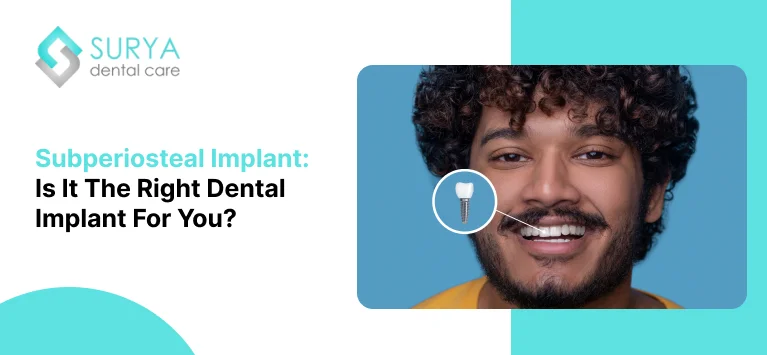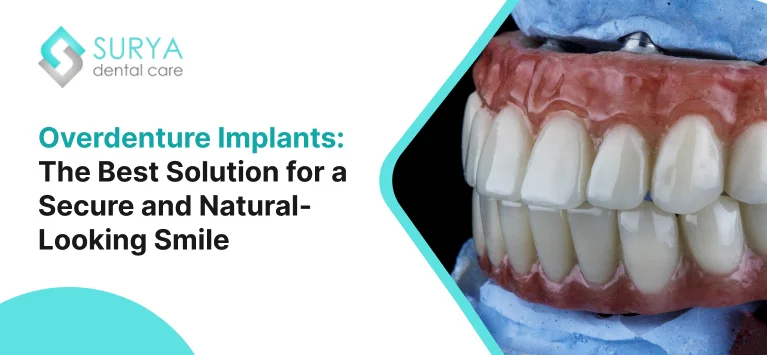Dental Implants are the best solution for lost teeth as they are the most effective and long-lasting. There are many types of implants, and choosing the most suitable one could give you the best results. Among the types a subperiosteal implant is one of the types, and to learn more about it, continue reading. You will know what a subperiosteal implant is, the best fit, and the advantages, disadvantages, and alternatives.
What Is a Subperiosteal Implant?
A subperiosteal implant is a dental implant that sits on top of your jawbone but underneath the gum tissue. The other most commonly used endosteal implants are placed directly into the bone, while the subperiosteal implants rest just above the bone but beneath the periosteum (a connective tissue layer).
Subperiosteal implants use custom-made metal frames or structures designed to fit your jaw perfectly. Small posts attached to the frame protrude through the gums, allowing crowns or bridges to be mounted securely.
When Are Subperiosteal Implants Recommended?
Subperiosteal implants are ideal for patients who,
- Do not have enough healthy jawbone for traditional implants
- Cannot or do not want to undergo bone grafting
- Have bone loss due to periodontal disease or long-term denture use
- I prefer a less invasive option compared to full-on bone augmentation.
If you have been told your bone volume is insufficient, a subperiosteal implant might be your best alternative.
Advantages of Subperiosteal Implants
Ideal for Bone Loss Cases: The biggest benefit of a subperiosteal implant is that it can be used even when there’s severe bone resorption. No bone grafting is required.
- Custom Fit: These implants are tailor-made for your jaw structure using 3D imaging or CT scans to ensure a secure and precise fit.
- Faster Healing: Since drilling into the bone is unnecessary, the healing process is usually quicker than with endosteal implants.
- Minimally Invasive: It offers a viable implant option with reduced surgical intervention, which helps older patients or those with medical limitations.
Disadvantages of Subperiosteal Implants
Despite their benefits, they also have certain drawbacks that come with subperiosteal implants. They are,
- Lower Long-Term Success Rate: Compared with endosteal implants, subperiosteal implants have a higher risk of complications like infection or implant failure.
- May Cause Gum Irritation: Because the metal frame sits under the gum, some patients may experience discomfort or gum inflammation.
- Higher Cost: These implants may cost more than traditional ones as they are custom-designed and even cost more when fabricated using advanced imaging technology.
Alternatives to Subperiosteal Implants
If you are looking for an alternative to subperiosteal implants, consider the tooth replacement options below.
1. Endosteal Implants
These are the most common types of implants directly inserted into the jawbone. They have the highest success rate but require good bone density.
2. Zygomatic Implants
Anchored in the cheekbone (zygoma), these are ideal for patients with severe bone loss in the upper jaw.
3. All-on-4 Implants
This technique uses four strategically placed implants to support a full-arch denture that often avoids bone grafting.
4. Removable Dentures
Removable dentures are more budget-friendly, and non-surgical options are less stable than implant-supported prosthetics.
Subperiosteal vs Endosteal Implants: Which Is Better?
Feature |
Subperiosteal Implant |
Endosteal Implant |
| Placement | On the jawbone | Inside the jawbone |
| Bone Grafts | Rarely required | Often required |
| Best for | Thin or damaged jawbone | Healthy jawbone |
| Stability | Moderate | High |
| Cost | Higher | Moderate |
Takeaway
Suppose you’ve been told you’re not a candidate for traditional implants due to jawbone loss. In that case, you need not lose hope, as advancements in dental technology have given subperiosteal implants a strong and lasting solution without the need for extensive surgery. With proper planning and oral hygiene, a subperiosteal implant can restore your smile and confidence for years.
Consult an experienced Surya dental care implantologists to assess your oral condition and determine whether a subperiosteal implant is the most suitable choice.











Leave a Comment